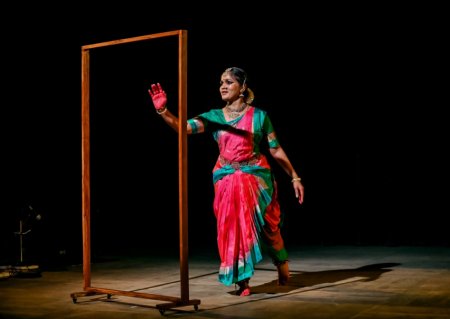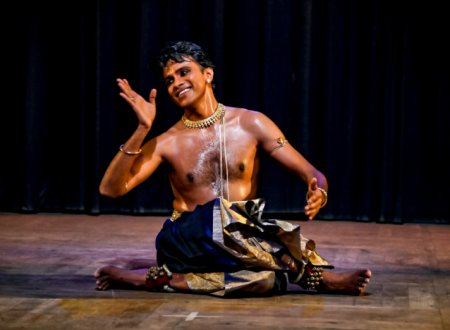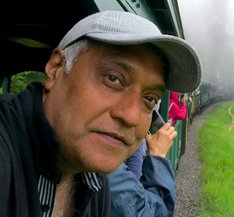
|   |

|   |
Padmini 2023 - Dr. Rajiv Rajamani e-mail: rajivrajamani1@gmail.com October 2, 2023 Dancer and Arts entrepreneur Keerthana Ravi presented the fourth edition of Padmini, a festival in memory of her Guru Padmini Ramachandran. The festival celebrated two soloists conceptualising their own production - Rohini Dhananjaya from Bangalore and Anand Satchidanandan from Mumbai. Rohini's Bharatanatyam may be described as profuse and prolific, malleable and intricate like Hoysala sculpture. Anand's dance is statuesque like a Chola bronze, his height giving depth to the angular shapes permeating the movements. While Vazhuvoor and Kalakshetra influences particularise their choreographic styles respectively, the dances themselves give an insight into who they are and what history has brought them to this point in their lives. Rohini Dhananjaya - Bimb Rohini Dhananjaya's Bimb is the journey of exploration and self-discovery of a young girl reflected in a triad of Devis. Rohini begins with a strong and playful interpretation of Kali, the personification of time. As a small child she creates ephemeral sand castles and kolams before erasing them with an offhanded sweep. She pounds her feet with a wide legged stance to tame the earth. She laps up Raktabija's blood and stands panting with pendant tongue. As Tara Devi the choreography gives life to the act of Shiva being nursed at her breasts; her milk acting as an antidote for the poison he had consumed during samudra manthana. The fleshliness of the act is shocking, yet spontaneously maternal.  Rohini Dhananjaya Rohini's movements emanate from a very strong core. The shapes that flow from that base speak their own language. Her spatial awareness etches the shape of a mandala on stage as she shoots flower arrows to cross rhythms. The dancer shapes a triangle with her limbs symbolising the Feminine. It has a sense of groundedness from the base to the apex, a hint of where the energy is heading. This is juxtaposed with the inverted triangle cueing unpredictability. Geometry conveys intention. These shapes are not random formations - they embody the music's emotional and energetic charge. By now the rhythm has summited to the sankirnam cycle of nine beats, three times three. The girl has also metamorphosed into the third Goddess of the Triad, Shodashi who embodies the fullness of the sixteen kalas or divine attributes. Dr. Himanshu Srivastava's scholarly narrative provided gravitas. Dr. Sridhar Vasudevan's music was lush and multifaceted, authentic textual sources imbuing the dance with literary flavour. Rohini's choreography was flowing and supple, but never indolent. Every movement was sealed with a tightening bandha that locked the pose giving it punch and taut articulation like a plucked rava gamaka (embellishment) at the end of a musical phrase. She exuded an instinctive grasp of breath and bandhas, locking and releasing the flow of energy through her body as she danced. Anand Satchidanandan - Antardhwani We already abide within creation, so any narrative on the process of creation has got to be retrospective - before words, before language and before meaning. In a sense Prajesh Nair's energetic mohra solo played with gusto on the mridangam had enormous suggestive impact even before the dancer appeared on stage.  Anand Satchidanandan Anand opened his performance with the story of creation as envisaged in the Maheshwara Sutram and Nandi Chol. Sidhi Krishnamoorthy's stentorian voice and Jayalakshmi Anand's charged nattuvangam energized the atmosphere. Shiva's damaru (kettle drum) in the dancer's hands sounded clearly 14 times, articulating the aural universe of language, his feet danced to the laya that was born therewithal while his expressions began to convey meaning. The dancer interpreted Gopalakrishna Bharati's Enneramum (at all times) as a clever allegory for the present moment and also eternity. He employed its slow tempo paradoxically to heighten the awareness of time or laya. Anand was able to build an interior scape of charged emotions and also externalize the lyrics by delineating the grand architecture of the Chidambaram temple. The dancer invited a host of extra-musical associations through depiction of animals and birds as the arohana of Mayamalavagoula was scaled. However during the avarohana the horse (dhaivata) went missing! And the discerning ones in the audience knew what to expect - ragam Jaganmohini. Anand brought refreshing new life to Thyagaraja's sublime Sobillu Saptasvara. The choreography was lively, darting, spiralling and grounded by robust footwork. In every jathi Anand tried to reach for something beyond and then unexpectedly landed into the seated gomukhasana position with daring lightness. An insouciant wave of his hand - veechu (khali in a rhythmic cycle) insinuated the emptiness, the voiceless origins of sound - anahata! The plaintive notes of Varali played on the violin by Mangala Vaidyanathan drew the audience towards the exuberance of Tamil in the Shivapuranam of Manikkavachakar. The dance softened into tranquil ease. Somewhere amongst the hushed audience a slumbering infant let out a whimper as the song of Agastya crooned: Kanavil uruvakiya kaviyam kanden (I dreamt up a poem). The dance ended with a denouement of grace; poignant, but incredibly warm. A small toddler appeared and drifted off stage like a rustling breeze. He seemed to hold on to the hand of someone for support. The child was there but I ceased to see the dancer. Anand Satchidanandan is a rare artiste who is beginning to realise the significance of Bharatanatyam's mystical and spiritual range. Dance as a way of being in the world, integrated into one's lifestyle rather than peripheral to it.  Rajiv Rajamani is a film maker, author and connoisseur of classical music and dance based in Bombay, Auckland and Chennai (during the season). |